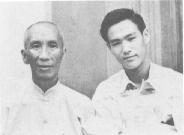History of Wing Chun
There have been many accounts as to the
origins of Wing Chun and its true age can only be approximated to
be between 350 - 500 years old.
Without going into any great depth the
story I was told goes like this. Legend has it that a Buddhist nun
name Ng Mui, frustrated at not being able to compete with the monks
due to size and strength, was out walking one day when she witnessed
a fight between a crane and a snake, and adapted what she saw to suit
the human body.
This was a revelation at the time, as
the arts of the day were based on emulating the movements of various
animals and insects rather than adapting them.
While fleeing the emperors soldiers after
the burning of the Siu Lam ( Shaolin ) monastery of Mt. Sung in the
Honan province of China, she met Madam Yim Wing Chun, a local merchants
daughter.
Yim Wing Chun was being pursued by a
local warlord who wanted her for his wife, and was willing to take
her by force. Ng Mui felt sorry for Yim Wing Chun and agreed to teach
her the newly developed style she had designed.
She told her to tell the warlord that
if he could beat her in combat she would agree to marry him to which
he agreed. After training with Ng Mui for 100 days, she met and beat
the warlord using her newly found skills and eventually married the
man of her choice.
She taught her skills to her husband
Leung Bok Chau, who later named the system " Wing Chun " in reverence
to his wife. Yim Wing Chun and her husband continued to develop the
style and later sold the techniques to other martial artists.
The style of Wing Chun percolated down
the generations and family trees until the legendary Yip Man brought
the style to Hong Kong in around 1918 where he began teaching his
skills.
Its was Bruce Lee (studied under Yip
Man) who opened the western worlds eyes to the art of Wing Chun Kung
Fu, and although he had not completed the syllabus his skills caused
people to sit up and take notice.
Bruce Lee later developed his controversial
style of Jeet Kune Do, which is mostly based on the Wing Chun system.
|

